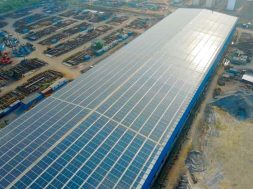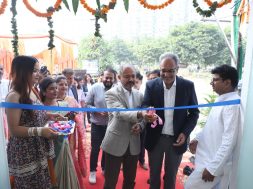Fenestration: arrangement beyond visual comfort

Using components to enhance design, right planning, utility space etc., determine longevity and durability.
Arrangement of doors and windows in a building plan is determined by a multitude of considerations. For deciding the position, size and type of door, an architect needs to consider utility of each room. Wastage in circulation area needs to be minimised. Hence, it is guided by arrangement of furniture and other gadgets inside that room. Whether room needs hinged door or revolving door or single panel or double leaf or folding door or sliding door, etc.
The design consideration for arrangement of doors and windows are air movement, creating peculiar environmental conditions in space. Whereas design consideration for doors, a moving structure at an enclosed space. Doors normally consist of panel, with interior and exterior faces. The design considerations for doors include – brands, materials, functionality, and performance and so on – the process can become mind-boggling. Doors make one feel safe with security features like multipoint locking, extremely strong hinges and toughened laminated safety glasses. Window Magic doors are a perfect way to add charm and beauty to one’s home, says Manish Bansal, Director and CEO, Window Magic India.
Types of windows
Sliding windows – Sliding windows adds panache to the home; it gives a sleek and elegant look to the beauty of the room. Sliding windows are the most elegant choice for home design.
French windows – French windows add glamour to the interior space. They provide view of the surroundings and add the element of nature to the interior spaces. During the day, they light up the interiors, whereas at night the building glows through these windows.
Conservatory – Nothing can surpass the beautiful innovation and charm of a classic conservatory. With their elegant lines and exquisite detail, these structures are the ultimate extension between the living space and the beautiful natural environment around. Victorian conservatories offer a truly beautiful space to relax and enjoy the surroundings.
Picture windows – They are best in areas where airflow is not important. Picture windows are often installed high on walls and hallways, providing excellent lighting. This type of windows, when used in conjunction with full louver doors, creates the perfect combination of airflow and light. These types of windows provide visual appeal only. If the glass area is too large, the window becomes susceptible to vandalism, and replacing glass could be expensive.
Location, height and size
Depending on the location, height of the building and size of the windows or doors it is important to consider wind load, accidental load due to human impact, noise reduction, thermal insulation, corrosion resistance of profile and hardware, visual light transmittance, solar factor and air tightness, according to Satish Kumar, Country Manager, Deceuninck Profiles India Private Limited.
“Air tightness and noise has become a major concern in cities due to increasing noise and pollution levels,” he adds.
Important points to keep in mind
To have the perfect doors and windows to a home or office it is absolutely vital to keep a few of the points in mind:
U-value with its thermal transmittance, (U-value), low-energy: E-glass thermal which has maximum heat deflection, it means a very low U-value; it stops the temperature from passing the glass, which gives it an edge over other windows material options. “The U-value which is a measure of the rate of heat loss is expressed in watts per square meter, per degree Kelvin. Lower U-values can be attained if there is a use of multiple glazing layers, gases, and low e-coating,” says Mario Schmidt, Managing Director Lingel Windows and Doors Technologies Private Limited.
Steel reinforced: Lingel windows are fitted with galvanised steel reinforcement it does not bend easily and is very stable to use in uPVC windows and doors.
Double seals an added advantage: The double seals used in the uPVC windows helps to keep rainwater outside as much as possible while sealing the glass pane against the uPVC window. And that’s not all in areas where one may experience a lot of dust these windows can help prevent dust from entering in.
Low on maintenance: uPVC windows do not need regular cleaning or maintenance. It is once in a lifetime investment. uPVC windows also help in energy saving. uPVC windows and doors will help reduce the heat coming from outside, keep the place cool, and will help reduce electricity bill.
Good selection for windows orientation, optimising the size of glass and selecting the ideal glass performance with the help of solar heat gain coefficient, U-factor, and visible transmittance etc., are important design considerations for fenestration, says Prof. Charanjit S Shah, Founding Principal, Creative Group.
Customising these factors based on the climate and topography of a region drastically influences a buildings performance.
Casings and sashes: This includes wood windows, aluminium windows, and fibreglass windows. These materials affect cost, performance, and the overall aesthetics of the windows. In many cases the sashes of vinyl and aluminium windows are filled with foam for a boost in efficiency. Insulation and the type of seal between the structural members and glass impacts thermal performance of the window.
Glazing: There is single glass pane, or more commonly today, double and triple glazing. The layers of double and triple glazed glass are separated by a space which creates and airtight seal. The space(s) between the glasses is filled with an inert gas such as argon.
Tinted glass: Popular in warmer climates, tinted glass can reduce the heat gain during the long, hot days of summer.
Low-e glass: Modern, low-e glass is manufactured using a fine metal coating that substantially reduces the heat transfer by 25 per cent or more.
Utility space
There are multiple considerations for deciding arrangement of doors and windows in the building plan. For deciding the position, size and type of door, an architect needs to consider utility of each room. Wastage in circulation area needs to be minimised. It is guided by arrangement of furniture and other gadgets inside that room. Whether room needs hinged door or revolving door or single panel or double leaf or folding door or sliding door, etc. These factors are to be weighed properly, says Architect Surinder Bahga, Saakaar Foundation.
Likewise, for windows, local bye-laws, wind direction, rainfall, sun direction are important factors. Scale and aesthetic appeal of the building is equally important. Due to advancement in glass technology and knowledge, today architects have the options of using double glass windows, triple glass windows, security glasses in windows to suit climate, noise level and security concerns.
Plan right
It is imperative for one to plan the doors and windows in the right manner – a lot of design considerations are done, while doing so; first and foremost the orientation of the structure and its fenestration shall ensure best of natural yet glare free lighting percolates within, wind direction too is a consideration, while rain protection is another; it is also the balance of façade or elevation which is an important factor, while also ensuring the utility of the fenestration planned; all this along with making sure that if a door is planned, it is planned in a way that it is easily visible or approachable; Right planning of doors and windows shall be one of the most important deciding factors on the building’s internal comfort and external beauty, plus the longevity of the structure, according to Ar. Prem Nath, Prem Nath and Associates.
Understanding components is imperative
Glazed windows are becoming an important component of contemporary architecture. They allow natural light, offer a visual communication with outdoors, reduce a structural load and enhance aesthetic appearance of buildings. However, if they are not properly selected occupants will face problems.
AS per ECBC 2017 in case of fenestration, U-factors shall be determined for the overall fenestration product (including the sash and frame) in accordance with ISO-15099 by an accredited independent laboratory, and labelled or certified by the manufacturer.
One important consideration is the fenestration of a building. Fenestration is any opening in a building’s envelope including windows, doors and skylights. Anything placed into that opening (glass, frame, and attachments) is considered a part of that building’s fenestration.
“Understanding the effect of each component of fenestration and how to use that data to contribute to innovative design is a key for architects and designers,” says Ar. Er. S.P. Anchuri, Chief Consultant, ECBC Expert, Anchuri and Anchuri.
There are many factors concerning fenestration that an architect and or designer should consider depending on the specific goals of the project. Is the design intent to reduce heat gain? Is the project goal to increase natural day lighting and reduce the dependency on artificial light? Is the main concern controlling visual comfort in an occupied environment? Hence, understanding all the components of fenestration and their functioning is crucial.
Understanding fenestration
Wide array of colour options
Window Magic offers a wide array of colour options to match the aesthetic preference of the house. The company also have several other popular colour schemes, which can avail on order. Apart from colour options, Window Magic involves an impressive portfolio of uPVC profiles encompassing beautiful and functional designs that will surely give house a striking appearance. “Our uPVC windows and doors are suitable for bedrooms, balconies and many other parts of the building as they come with intricate patterns to beautify the interiors and its surroundings,” says Bansal.
3 wood lamination colours
Traditionally, uPVC windows have been provided in white. Deceuninck offers in white and 3 wood lamination colours and three solid lamination colours. This brings in a lot of aesthetic value to the customers’ interiors. He/she can match the colour to his furniture or floor or wall colouring. “We will be starting local lamination from early 2019 and will offer more colours to help customers choose from a wide palette,” says Kumar.
Weather conditions, life style and acoustic
“The colour palette: colours add a glam factor to make the windows or doors look aesthetically appealing. uPVC windows are available in a number of hues. Walnut and golden oak coloured doors are in demand. These have a finish and look of wood from a distance,” says Schmidt.
Besides the colour it is also very crucial that one decide what type of window will go well in which area. The weather conditions, life style and acoustic are all important factors to bear in mind. Always remember different rooms may require a different kind of window so have the right one installed.
“Facade can add aesthetic value and commercial value to a built mass along with providing shade and insulation,” says Prof. Charanjit S Shah, Founding Principal, Creative Group
Shading devices
Shading devices, components and parts of the windows play a major role to add aesthetic value of fenestration, says Bahga. Many a times, recessed windows are opted by famous architects like Mario Botta to give the building a very neat look.
Recently completed ‘al Bahr towers’ in the United Arab Emirates, the new headquarters of the Abu Dhabi, where the dynamic façade opens and closes in response to the sun movement, reducing solar gain by up to 50 per cent. Referencing the ‘mashrabiya’, a wooden lattice system found in vernacular Islamic architecture, a series of translucent umbrella-like components which open and close in relation to the sun. Each shading device is driven by a linear actuator and dramatically reduces the amount of sunlight striking the building, avoiding the need for tinted glazing.
Fenestrations add a lot of aesthetics to the structure – these could make or break the beauty of the building – be it fully glazed facades or rhythmically placed windows, or even randomly but aesthetically appealing cut-outs, according to Nath.
To add to the aesthetic value further, are the variety of windows and doors available – depending on the theme or mood of the project the windows and doors are selected; be it wooden frames with glass panes or aluminium frames with glazing or uPVC windows or simply louvers – similarly wooden door frame with panel door, or metal door or partly glazed door or fully glazed door – all these choices decide on the look (read aesthetic) of the building; another important aesthetic factor shall be the colour of the glass and the finish or pattern on it.
“Today, we have evolved above these factors and gone beyond to solar active facades – with photovoltaic films being clad on the face of the building to enable generate solar energy, all day long – a green feature not just adding to the aesthetic value but also the sustainability factor of the building,” he adds.
“Architecture is an art form that’s equal parts design and functionality, so one needs to first talk about how fenestration impacts a structure in a practical sense and refers to the openings in a building’s facade, most notably doors and windows allowing passage from outside to inside. Turns out, holes in the structure can actually be pretty useful and having high aesthetic value,” adds Anchuri.
Selection criteria
Benefits:
Weather resistance – uPVC will not change shape under normal weather conditions but can be reshaped at very high temperatures. “uPVC windows are more energy-efficient than those with wooden or metal frames. Moreover, uPVC can also be used for door frames and conservatories,” says Bansal.
Longevity – If one is looking for long-lasting options for windows and doors, uPVC is no doubt the right material. The strength of uPVC is unmatched by any other fenestration material in the market.
Eco-friendly – These products are 100 per cent recyclable and reusable. And unlike PVC that contains phthalates, uPVC does not contain any harmful elements in them; ideal for the environment conscious individuals.
Minimal maintenance – uPVC windows and doors require minimum maintenance. One does not require tightening bolts, readjusting the frame or changing parts frequently. Once installed, it will sit there unshaken for a lifetime.
Cost effective – uPVC is cheap to manufacture and are priced in a way that makes them more affordable than materials like wood or aluminium.
Hardware, glass and installation play a big role
Today, uPVC is considerably economical compared to aluminium on a per kg basis. Good quality uPVC profile with tropical formulation would be in the range of Rs. 150 – 170/Kg in white whereas aluminium with white powder coating would be in the range of Rs. 240 – 260/Kg.
“Hardware, glass, reinforcement, proper installation play a big role in the final window cost. If a well-designed window is considered, uPVC will definitely be more affordable,” says Kumar.
uPVC and aluminium – affordable materials
uPVC and aluminium are affordable materials. There’s been a growing fondness for these windows in India not just because they are cost effective but are conducive to the weather conditions of this region as well, says Schmidt. Such windows are energy efficient and low on maintenance.
Lingel 6.0 aluminium windows
Lingel 6.0 aluminium windows has features like 60-mm wide section for frame and shutter, 2-mm outer wall thicker, glued corner connector, SS grade and glued corner connector for all visible parts of the corners, first in industry Z mullion used for outside or inside glazing, Lingel SS grade hardware, heavy duty friction hinges up to 50 kg per panel can be fitted, glass thickness up to 36 mm, chambers can be steel reinforced for additional strength.
Weather conditions, lifestyle and acoustic are all important factors to bear in mind.
Mario Schmidt, Managing Director, Lingel Windows and Doors Technologies Private Limited
Doors make one feel safe with security features like multipoint locking, extremely strong hinges and toughened laminated safety glasses.
Manish Bansal, Director and CEO, Window Magic India
Facade can add aesthetic value and commercial value to a built mass along with providing shade and insulation.
Prof. Charanjit S Shah, Founding Principal, Creative Group
For deciding the position, size and type of door, an architect needs to consider utility of each room.
Architect Surinder Bahga, Saakaar Foundation
Right planning of doors and windows shall be one of the most important deciding factors on the building’s internal comfort and external beauty.
Ar. Prem Nath, Prem Nath and Associates
Understanding the effect of each component of fenestration and using the data to contribute to innovative design is key for architects and designers.
Ar. Er. S.P. Anchuri, Chief Consultant, ECBC Expert, Anchuri and Anchuri
Hardware, glass, reinforcement, proper installation play a big role in the final window cost.
Satish Kumar, Country Manager, Deceuninck Profiles India Private Limited
28
Cookie Consent
We use cookies to personalize your experience. By continuing to visit this website you agree to our Terms & Conditions, Privacy Policy and Cookie Policy.









